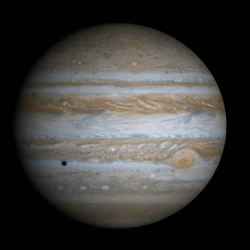
Jupiter. Image credit: NASA/JPL Click to enlarge
Turbulence driven by sunlight and thunderstorm activity may explain the multiple east-west jet streams on Jupiter and Saturn and even produce strong winds extending hundreds or thousands of kilometers into the interior, far below the altitudes where the jets are driven.
Scientists have been trying to understand the mechanisms that form the jet streams and control their structure since the first high-resolution images of Jupiter were returned by the Pioneer and Voyager spacecraft in the 1970s.
On Earth, the jet streams — narrow currents of air flowing from west to east in the midlatitudes — form a major component of our planet’s global circulation, and they control much of the large-scale weather experienced by the United States and other countries outside of the tropics. Similar east-west jet streams dominate the circulation of the giant planets Jupiter, Saturn, Uranus, and Neptune, reaching up to 400 miles per hour on Jupiter and nearly 900 miles per hour on Saturn and Neptune. The question of what causes these jet streams and how deep they extend into the interior of the giant planets remain some of the most important unsolved problems in the study of planetary atmospheres.
Adam Showman and Yuan Lian of The University of Arizona in Tucson and Peter Gierasch of Cornell University in Ithaca, New York, explained how cloud-layer turbulence can drive deep jets at the 37th annual meeting of the Division of Planetary Sciences of the American Astronomical Society, held in Cambridge, England.
Lian, Showman, and Gierasch performed computer simulations showing that horizontal temperature contrasts — generated by sunlight or differences in thunderstorm activity — can produce multiple jet streams that penetrate deep into the interior of a giant planet. In the simulations, the temperature contrasts induce deep-penetrating circulation cells that in turn drive the deep jets. The study, which uses an advanced three-dimensional computer model, is among the first that allows an assessment of how jets formed near the top of the atmosphere interact with the interior.
Most planetary scientists have assumed that jets pumped near the top of the atmosphere will remain confined to those shallow layers, and we’ve shown that this is not a valid assumption,” Showman said.
NASA’s Galileo Probe, which parachuted through Jupiter’s atmosphere in 1995, was intended in part to help answer the question of how deep the jet streams extend. The probe found strong winds extending at least 150 kilometers (almost 100 miles) below the clouds. Planetary scientists have widely interpreted this measurement as evidence that the jets are driven from deep inside Jupiter’s interior. The new study challenges this interpretation.
“We still don’t know whether the jets on the giant planets are driven from the top or within the deep interior,” Showman said. “But our study shows that the deep winds measured by the Galileo probe could just as easily result from shallow cloud-layer turbulence as from turbulence deep inside Jupiter’s interior.”
“This result contradicts a long-standing assumption on the part of many planetary scientists.”
The new study also shows that, under realistic conditions, the turbulence can produce not only numerous jet streams but a strong eastward flow at the equator, as observed on Jupiter and Saturn. Such flows are notoriously difficult to produce in atmospheric models, Showman noted.
Original Source: NASA Astrobiology
